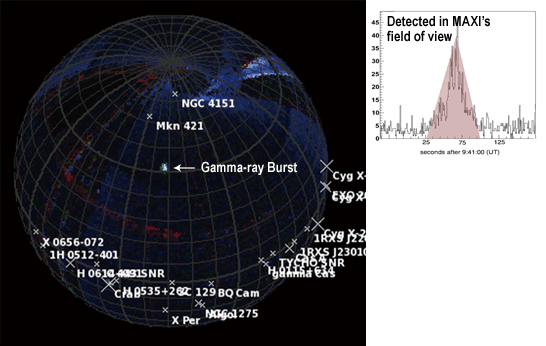TOP > Report & Column > The Forefront of Space Science > 2009 > Monitor of All-sky X-ray Image (MAXI) Starting to Watch the Dynamically Changing Universe
![]()

On Aug. 31, 2009, MAXI first detected a gamma-ray burst (strictly speaking, X-ray radiation caused by gamma-ray burst) (Fig. 5). A gamma-ray burst is the most intensive brightness-increasing phenomenon known in the universe. Since the duration of a gamma-ray burst is short, namely less than several seconds at its shortest and several minutes at longest, it is highly probable that MAXI would overlook its occurrence as with X-ray burst cases. We estimate that the probability of detecting gamma-ray burst would be two per year. Nevertheless, earlier than expected, on Sep. 27 a second gamma-ray burst occurred within view of MAXI and was successfully observed. We posted our analysis results on the Gamma-ray bursts Coordinates Network (GCN): specifically, two reports on the burst in August (GRB 090831A) and one report on the burst in September (GRB 090926B). The detection of gamma-ray bursts by X-ray could contribute to the elucidation of the radiation model. The detection of GRB 090831A by MAXI greatly contributed to determination of its location. Concerning GRB 090926B, MAXI happened to catch its X-ray radiation 17 seconds before the automatic detection by Swift, the gamma-ray burst observation satellite (it is guessed that there was some time delay between gamma-ray radiation and the satelliteís automatic detection). MAXIís capability to monitor constantly the entire sky provides us with opportunities to observe scientifically valuable moments. On Oct. 24, 2009, MAXI team learned of the emergence of an X-ray nova (a body thought to be a candidate for a black hole) through the ATEL (Astronomer's Telegram) mailing list. The team immediately checked the accumulated data. It found that MAXI took images of the X-ray nova (XTE J 1752-223) that brightened through Oct. 23 to 25. We immediately reported our finding to ATEL. X-ray novae usually brighten over several days and then darken over several months. X-ray novae are important observation targets for MAXI since they can be discovered and monitored by MAXI without oversight. This is because their brightening duration is much longer than MAXIís scan cycle (90 min.). In addition, we have reported two brightening events of pulsars (neutron stars), A0535+26 and 4U2206+54, and one huge X-ray flare event of a close binary system (UX Ari) in an international academic conference and physical/astronomical conferences. In the case of 4U2206+54, we also posted on the ATEL. MAXI is the first to realize all-sky monitoring sooner, faster, and in a more detailed manner than ever before. At present, we are searching for brightening bodies with our eyes, but this will become automated when the nova search system soon begins full operation. 
Conclusion We are improving the software by feeding back calibration results so that we can catch the emergence of new bodies without fail and immediately report their accurate coordinates. We will publish all-sky images corrected for exposure time and positional error. After quick notices, we will publish our data. The latest information is available on the MAXI homepage. The MAXI team is led by mission leader Matsuoka and its members are: JAXA (Matsuoka, Kawasaki, Ueno, Tomita, Obama, Suzuki, Adachi, Ishikawa, Sakamoto, Kobayashi, Katayama, and Ebisawa); RIKEN (Mihara, Sugizaki, Nakagawa, and Yamamoto); Osaka University (Tsunemi and Kimura); Tokyo Institute of Technology (Kawai, Morii, and Sugimori); Aoyama Gakuin University (Yoshida, Yamaoka, Nakahira, and Takahashi); Nihon University (Negoro, Nakajima, Miyoshi, Ishiwatari, and Ozawa); Kyoto University (Ueda, Isobe, Eguchi, and Hiroi); and University of Miyazaki (Yamauchi and Daikyuji). MAXI is being operated in cooperation with the Human Space Systems and Utilization Mission Directorate of JAXA and cooperating companies. Shiro UENO |
| | 1 | 2 | 3 | |




